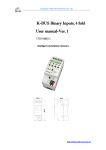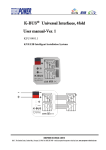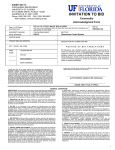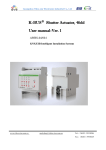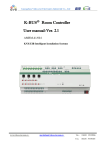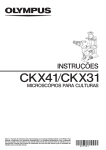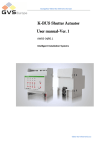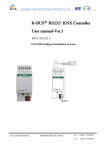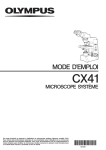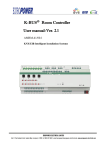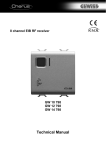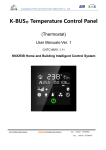Download K-BUS R Binary Inputs, 4 fold User manual
Transcript
Guangzhou Video-star Electronics Industrial Co., Ltd R K-BUS○ Binary Inputs, 4 fold User manual-Ver. 1 CTBI-04/00.1 KNX/EIB Intelligent Installation Systems www.video-star.com.cn [email protected] Tel.: (8620)39338986 Fax: (8620)39338465 R GVS K-BUS○ KNX/EIB Binary Inputs, 4fold Contents 1. General ------------------------------------------------------------------------------------------------------------------------ 3 1.1 Product and functional overview--------------------------------------------------------------------------------------- 3 2. Technical data --------------------------------------------------------------------------------------------------------------- 4 3. Circuit and dimension diagram --------------------------------------------------------------------------------------- 5 3.1Circuit diagram -------------------------------------------------------------------------------------------------------------- 5 3.2Dimension diagram--------------------------------------------------------------------------------------------------------- 6 4. Project design and programming ------------------------------------------------------------------------------------- 6 4.1Overview of the functions ------------------------------------------------------------------------------------------------ 6 5. Parameter setting description in the ETS ------------------------------------------------------------------------- 8 5.1 Parameter window“General Setting” --------------------------------------------------------------------------------- 8 5.2 Parameter window“Manual/Automatic Setting” ------------------------------------------------------------------- 9 5.3 Parameter window“Enable/Disable manual operation” ---------------------------------------------------------11 5.4 Parameter window“Channel LED” -----------------------------------------------------------------------------------13 5.5 Parameter window“Preset Channel A~D” --------------------------------------------------------------------------14 5.5.1 Jointly adjustable working mode for binary input ----------------------------------------------------------15 5.5.2 Separately adjustable working mode for binary input ----------------------------------------------------17 5.5.2.1 Switch operating mode---------------------------------------------------------------------------------------------------18 5.5.2.2 Switch/Dimming operation mode ------------------------------------------------------------------------------------- 25 5.5.2.3 Value/Forced output ------------------------------------------------------------------------------------------------------28 5.5.2.4 Scene control --------------------------------------------------------------------------------------------------------------- 31 5.5.2.5 Switching sequence -------------------------------------------------------------------------------------------------------36 5.5.2.6 Counter ---------------------------------------------------------------------------------------------------------------------- 39 5.5.2.7 Push button with multiple operation ---------------------------------------------------------------------------------- 45 5.5.2.8 Shutter Control------------------------------------------------------------------------------------------------------------- 49 6. Description of communication object ------------------------------------------------------------------------------52 6.1 Communication object “Manual/Automatic” ----------------------------------------------------------------------52 6.2 Communication object “Jointly adjustable [Dimming]” --------------------------------------------------------53 6.3 Communication object “Jointly adjustable [Shutter]” -----------------------------------------------------------54 6.4 Communication object “Switch” --------------------------------------------------------------------------------------54 6.5 Communication object “Switch/Dimming” ------------------------------------------------------------------------55 6.6 Communication object “Value/force output” ----------------------------------------------------------------------56 6.7 Communication object “Scene control” ----------------------------------------------------------------------------- 57 6.8 Communication object “Switch sequence” -------------------------------------------------------------------------58 6.9 Communication object “Counter” ------------------------------------------------------------------------------------59 2 www.video-star.com.cn [email protected] Tel.: (8620)39338986 Fax: (8620)39338465 R GVS K-BUS○ KNX/EIB Binary Inputs, 4fold 6.10 Communication object “Multiple operation” --------------------------------------------------------------------61 6.11 Communication object “Shutter control” -------------------------------------------------------------------------62 1. General The Binary input fulfils the individual demands in functional buildings as well as in residential buildings. In the same way, system planners are provided with varied application possibilities with regard to the implementation of functions. The binary input can install to be system with EIB/KNX bus and other device, and the functions are both simple to operation and intuitive. Users can program it according to the requirement to implement the function systematically. This manual provides detailed technical information about the binary input for users as well as assembly and programming details, and explains how to use the binary input by the application examples. 1.1 Product and functional overview The binary input is a modular installation device for fast installation in the distribution board on 35 mm mounting rails to DIN EN 60 715. The electrical connection is implemented using screw terminals. The connection to the bus is implemented using the supplied bus connection terminal. The binary input is connected to the input directly instead of an extra voltage supply. It is able to use the Engineering Tool Software ETS (ETS2 v1.3 or later) with a VD2/VD3 file to allocate the physical address and set the parameters, but a VD3 file imported is required for EST3 software. The devices feature one manual operation button and one LED per channel. The inputs can be operated manually with this button, and the LED indicates contact connection state. In the case of manual operation, there is no additional voltage input. The binary inputs serve as interfaces for operation of EIB/KNX systems via conventional buttons/switches or for coupling of binary signals (signal contacts, such as input 24V~230V). The binary input has many functions that can be used in a wide variety of application areas. The following list provides an overview: Switch and dimming function. (also 1 button operation) Control of blinds and shutters. (also 1 button operation) Sending of values e.g. temperature values、time etc. Control and storing of light scenes. 3 www.video-star.com.cn [email protected] Tel.: (8620)39338986 Fax: (8620)39338465 R GVS K-BUS○ KNX/EIB Binary Inputs, 4fold Operation of various loads by multiple push button actions. Operation of several loads in a fixed switching sequence. Standard counting and differential counting Channel disable/enable function Each input can take over any of the functions described above. Buttons on the front of the device can be used to simulate the input state. The status of the inputs are displayed by LEDS. 2. Technical data Power supply Input Connections Bus voltage 21-30V DC,via the EIB bus Current consumption, bus <12mA Power consumption, bus <360mW Number 4 Permitted voltage range Un 0……265V AC/DC Input current In Max.2mA Signal level for 0-signal 0……3V AC/DC Signal level for 1-signal 9……265V AC/DC EIB/KNX Via bus connection terminal Inputs Using screw terminals Cable cross-section Multi core 0.2……2.5mm2 Single core 0.2……4.0mm2 Operating and display Tightening torque Max.0.6 Nm Permitted cable length ≤100M (cross section for 1.5mm2) Programming LED and button For assignment of the physical address Channel LED 1LED per channel for display of the elements input state Manual operation button 1 button per channel for changing the input Manual/Automatic LED State 1LED for display of the manual/automatic mode states Manual/Automatic button 1 button for switchover of manual and automatic mode Temperature rang Operation -5 °C ... 45 °C Storage – 25 °C ... 55 °C Transport – 25 °C ... 70 °C 4 www.video-star.com.cn [email protected] Tel.: (8620)39338986 Fax: (8620)39338465 R GVS K-BUS○ KNX/EIB Design Binary Inputs, 4fold Modular installation device Modular installation device,ProM Dimensions 90×36×64mm(H×W×D) Installation On 35mm mounting rails Weight 0.1KG Housing/color Plastic housing, grey Approvals EIB/KNX certificate CE mark In accordance with the EMC guideline and low voltage guideline 3. Circuit and dimension diagram 3.1Circuit diagram 1、 Programming button 4、 Manual/automatic LED 2、 Programming LED 5、 Manual/automatic button 3、 Bus connection terminal 6、 Connection terminals 5 www.video-star.com.cn [email protected] Tel.: (8620)39338986 Fax: (8620)39338465 R GVS K-BUS○ KNX/EIB Binary Inputs, 4fold 7、 Channel LED 8、 Manual operation button 3.2Dimension diagram 4. Project design and programming 4.1Overview of the functions Application program Max. number of communication objects Max. number of group address Max. number of associations Binary Inputs,4 fold 34 105 105 The following operating modes are available for each channel. Switch function / fault signal input The function is used for switching the lighting or scanning conventional contacts, such as dimmer and switch actuator. Distinction between long and short operation and cyclical sending of 6 www.video-star.com.cn [email protected] Tel.: (8620)39338986 Fax: (8620)39338465 R GVS K-BUS○ KNX/EIB Binary Inputs, 4fold the contact state are possible. Switch/dimming function For switching/dimming the lighting via a one push button or two push buttons function. Start-stop dimming and stepwise dimming as well as dimming via a single push button is possible. Value/force output It is possible to send different values or data types (e.g. temperature values, time or scene.) after a short/long operation. The activation/deactivation of the priority control of actuators is also possible. No distinction between long and short operation, sending different values or data types on rising/falling edge. Scene control The function is used for recalling and storing the states of several actuator groups. The actuator groups can be controlled via max. 6 individual objects. Switching sequence The function is used for the operation of several actuator groups in preset sequences, e.g. the latching relay. It is also used for operation of several loads in a fixed switching sequence. Counter This is used for counting input pulses. Different data types can be set for the counter. It is also able to set the counting rate, and whether to sending the current counting values cyclically to the bus. When enable the differential counter, the differential counter can reset the count value and report in count overflow. Count can be stopped in overflow. Thereby, it is convenient to count the daily consumption. Push button with multiple operation For triggering various functions depending on the frequency of the operation. A long operation can also be detected and trigger a function. Shutter control For movement/lamella adjustment of a blind or a shutter via a one push button or two push buttons function. Eight preset operating responses are possible in total. Channel disable/enable function 7 www.video-star.com.cn [email protected] Tel.: (8620)39338986 Fax: (8620)39338465 R GVS K-BUS○ KNX/EIB Binary Inputs, 4fold Each channel of a device can be disabled separately via a communication object. 5. Parameter setting description in the ETS 5.1 Parameter window“General Setting” Parameter window “General Setting” can be shown in fig. 5.1. The function is used for limiting the number of sending telegrams to the bus, which can affect the complete device. The device initialization takes about 5s. Fig.5.1 Parameter window “General Setting” Parameter“Limit number of Tele.” It is used to limit the number of sending telegrams to decrease the burthen on the bus. It is possible to set how many telegrams can be sent within an adjustment period. Options: Yes No 8 www.video-star.com.cn [email protected] Tel.: (8620)39338986 Fax: (8620)39338465 R GVS K-BUS○ KNX/EIB Binary Inputs, 4fold When yes is selected in this parameter the Period and Max. Number Tele. Within a period parameters appear. Parameter “Period” The limit time of sending telegrams is set with the parameter. Options: 300ms 500ms …… 10min When device completes initialization in bus voltage recovery, start the observation period, and start count the sent telegrams. As soon as the Max. Number of transmitted telegrams has been reached, no further telegrams are sent on the bus until the end of the observation period. With the start of a new observation period, the telegram counter is reset to zero and the sending of telegrams is permitted again. Parameter “Max. Number Tele. Within a period” This parameter sets the number of telegrams which can be sent within an observation period. Options: 1……255 5.2 Parameter window“Manual/Automatic Setting” Parameter window“Manual/Automatic Setting”can be shown in fig. 5.2. It is possible to switch between manual operation and automatic operation by pressing the manual/automatic button about 2s. When the manual/automatic operations are switched successfully, the manual/automatic LED will flash for three times. In the manual mode the manual/automatic LED is on. In the automatic mode the manual/automatic LED is off. The devices are in automatic mode after connection to the bus, and the respective manual operation buttons do not have a function. 9 www.video-star.com.cn [email protected] Tel.: (8620)39338986 Fax: (8620)39338465 R GVS K-BUS○ KNX/EIB Binary Inputs, 4fold Fig.5.2 Parameter window “Manual/Automatic Setting” Parameter “Manual/Automatic button” The parameter defines if the switchover between the “manual operation” and “automatic operation” operating states is disabled or enabled using the manual/automatic button on the binary input. Options: Enable/Disable by object Enable If the enable/disable by object is selected, the “En/Dis Man. /Auto” communication object appears. The object receiving telegram value “0” disable the manual/automatic button, and then the manual / automatic mode cannot be switched. If the object receiving telegram value “1” enable the manual/automatic button, and then the manual/automatic mode can be switched. If the enable is selected, the manual/automatic button has been enabled. Parameter “Manual to automatic method” This parameter defines how long the binary input remains in the “manual operation” state after the “manual/automatic button” has been pressed. Options: 10 www.video-star.com.cn [email protected] Tel.: (8620)39338986 Fax: (8620)39338465 R GVS K-BUS○ KNX/EIB Binary Inputs, 4fold By push button Automatically and by push button If the by push button option is selected, the binary input will remain in “manual operation” until the manual/automatic button is pressed again. If the automatically and by push button option is selected, the binary input will remain in “manual operation” until the manual/automatic button is pressed again or the parameterized Manual to automatic after [10…60000]*1s has timed out. Parameter “Manual to automatic after [10...60000]*1s” The parameter appears when automatically and by push button is selected in the parameter manual to automatic method. It is used for setting the time for automatic reset from the “manual operation” to “automatic operation” state after the last push of a button. Option:10……60000s Parameter “Report on Man/Auto status change” The parameter defines whether report on man/auto status change, and the current status can be sent to the bus. Options: Yes No If the “yes” option is selected, the “Report Man/Auto Status” communication object appears. The object sends telegram value “1”, the current status for manual operation; the object sends telegram value “0”, the current status for automatic operation. When operation status changed, the object sends the current status telegram on the bus immediately. 5.3 Parameter window“Enable/Disable manual operation” Parameter window “Enable/Disable manual operation” can be shown in fig. 5.3. It is used to set whether the respective manual operation buttons do have a function in the manual mode. 11 www.video-star.com.cn [email protected] Tel.: (8620)39338986 Fax: (8620)39338465 R GVS K-BUS○ KNX/EIB Binary Inputs, 4fold Fig.5.3 Parameter window “Enable/Disable manual operation” Parameter “Channel A...D Manual button” This parameter enables or disables the operation of the manual operation button. It is set separately for each channel. Option: Enable Disable If the “enable” option is selected, the manual operation button is enabled. The first time the manual operation button is actuated, closing of the “external contact” is simulated, nothing happens when the button is released. The second time the manual operation button is actuated, opening of the “external contact” is simulated, nothing happens when the button is released. If the “disable” option is selected, the manual operation button is disabled, and the manual operation buttons do not have a function. On disabled channels the respective channel LED will not react if the respective manual operation button is pressed. For safety-relevant systems such as for fault signals the button functions are inhibited using the disable option. 12 www.video-star.com.cn [email protected] Tel.: (8620)39338986 Fax: (8620)39338465 R GVS K-BUS○ KNX/EIB Binary Inputs, 4fold 5.4 Parameter window“Channel LED” Parameter window “Channel LED” can be shown in fig.5.4. It used to set channel LED indicate as a normal or inverted function for binary input in manual or automatic mode. Fig.5.4 Parameter window “Channel LED” Parameter “Channel A...X LED” This parameter is used to represent the LED display as a normal or inverted function. It is set separately for each channel. Option: Normal Inverted If the Normal option is selected,represent the LED display as a normal function, then contact is closed(signal is present), LED is on; Contact is open (no signal), LED is off. If the inverted option is selected,represent the LED display as a inverted function, then contact is closed(signal is present), LED is off; Contact is open (no signal), LED is on. 13 www.video-star.com.cn [email protected] Tel.: (8620)39338986 Fax: (8620)39338465 R GVS K-BUS○ KNX/EIB Binary Inputs, 4fold 5.5 Parameter window“Preset Channel A~D” Parameter window “Preset Channel A~D” can be shown in fig. 5.5. Channel function of Binary input can select two ways of working. If the separately adjustable working way is selected, each channel can be set separately. If the jointly adjustable working way is selected, two channels can be set to work jointly, such as channel A and channel B jointly, channel C and channel D jointly. Each jointly adjustable can be set separately, which is used to set dimming and shutter functions. It is able to switch and dimming together with one button operation input, and it is also able to move and stop shutter with one button operation. Fig.5.5(1)Parameter window “Preset Channel A~D”(separately adjustable working mode) 14 www.video-star.com.cn [email protected] Tel.: (8620)39338986 Fax: (8620)39338465 R GVS K-BUS○ KNX/EIB Binary Inputs, 4fold Fig.5.5(2)Parameter window “Preset Channel A~D”(Jointly adjustable working mode) 5.5.1 Jointly adjustable working mode for binary input In the jointly adjustable working mode for binary input, each jointly adjustable can be set separately, and parameters and objects which are assigned to each jointly adjustable are the same. Using channel A/B jointly adjustable as an example described, the parameters can be shown in fig.5.5(2). Parameter“Function Select X/Y” This parameter set work ways of channel X/Y. Options: Separately adjustable Jointly adjustable (dimming, shutter) If the “Jointly adjustable (dimming, shutter)” option is selected,channel X/Y for jointly adjustable work mode, in the follow parameters appear. Parameter “Function X/Y” The parameter set the functions of channel X/Y in the jointly adjustable, which is used to set 15 www.video-star.com.cn [email protected] Tel.: (8620)39338986 Fax: (8620)39338465 R GVS K-BUS○ KNX/EIB Binary Inputs, 4fold dimming or shutter. Option: Dimming with two inputs with stop telegram Shutter with two inputs with stop telegram The jointly adjustable function of channel X/Y can realize the dimming or the shutter via two objects. In automatic operation mode, channels input for 9~265V. In manual operation mode, channels input by manual operation buttons. Parameter “Channel assignment X/Y” The parameter set the function assignment of channel X/Y in the jointly function for dimming. Option: Off, darker / on, brighter On, brighter / off, darker Toggle, darker / Toggle, brighter Toggle, darker / Toggle, brighter If the “Off, darker / On, brighter” option is selected,represent input signal for “off, darker” when contact of channel X is closed, input signal for “stop darker” when contact of channel X is open. However, channel Y is opposite, Input signal for “on, brighter” when contact of channel Y is closed, input signal for “stop bright” when contact of channel Y is open. In the function assignment of channel X/Y other options are similar with the above option. The on/off formation is sent to the bus via the object “switch, X/Y”, the darker/brighter formation is sent to the bus via the object “dimming, X/Y”. Here setting the function assignment of channel X/Y in the jointly function for shutter. Option: MOVE Down/MOVE Up with stop MOVE Up/MOVE Down with stop If the “MOVE Down/MOVE Up with stop” option is selected, the shutter move down when contact of channel X is closed, the shutter move up when contact of channel Y is closed. When the contact of channel X/Y is open, the shutter stops moving down/up. Another option is similar with the above option. The shutter moves up/down via the object “Shutter move up/down, X/Y”. To stop shutter moving via the object “shutter stop, X/Y”. 16 www.video-star.com.cn [email protected] Tel.: (8620)39338986 Fax: (8620)39338465 R GVS K-BUS○ KNX/EIB Binary Inputs, 4fold Parameter “Connect contact type X/Y” The parameter defines whether the input contact is a normally closed or normally open contact when actuated for channels x/y. Options: Normally closed Normally open The parameters that are described in this chapter are based on normally open connect type as example, the normally close connect type is just opposite. Parameter “Debounce Time X/Y” This parameter is used to set the debounce time for channel X/Y. Debouncing prevents unwanted multiple operation of the input, e.g. due to bouncing of the contact. Options: 10ms/20ms/……/150ms 5.5.2 Separately adjustable working mode for binary input In the separately adjustable working mode for binary input, each channel can be set separately, and parameters and objects which are assigned to each channel are the same. Using channel A as an example described. Parameter window“Channel X” The parameter window “channel X” can be shown in fig.5.6. The channel operating mode is set with this parameter. Option: No function Switch Switch/Dimming Value / Forced output Scene Control Switching sequence Counter Multiple operation Shutter control Each operating mode is assigned to the corresponding parameters and objects, the follow chapters in detail. 17 www.video-star.com.cn [email protected] Tel.: (8620)39338986 Fax: (8620)39338465 R GVS K-BUS○ KNX/EIB Binary Inputs, 4fold Fig.5.6 Parameter window “Channel X” 5.5.2.1 Switch operating mode Parameter window “Switch operating mode” can be shown in fig. 5.4 and fig. 5.9. No distinguish between long and short operation in Fig.5.7. It is opposite in Fig. 5.9. 18 www.video-star.com.cn [email protected] Tel.: (8620)39338986 Fax: (8620)39338465 R GVS K-BUS○ KNX/EIB Binary Inputs, 4fold Fig.5.7 Parameter window “Switch”(No distinction long/short operation) Parameter “Distinction between long and short operation” This parameter defines whether the input distinguishes between a short and long operation. If “yes” is selected, there is a delay after opening/closing the contact to determine whether there is a short or long operation. Only then is a possible reaction triggered. The following diagram illustrates the function. Option: yes 19 www.video-star.com.cn [email protected] Tel.: (8620)39338986 Fax: (8620)39338465 R GVS K-BUS○ KNX/EIB Binary Inputs, 4fold No Note:The long operation in the below chapters are the same with here. TL is the period after which a push button action is recognised as a long operation. Parameter “Cyclical send Tele. “Tele. Switch”” This parameter is visible if there is no distinction between a short and long operation. It is able to set whether to send the current value of object “Switch, X” cyclically on the bus. Options: No Always If switch off If switch on If the parameter value “always” is selected, the object sends cyclically on the bus, regardless of its value is 0 or 1. If the parameter value “if switch off” or “if switch on” is set, only the corresponding object value is sent cyclically. Parameter “Reaction on closing the contact ( rising edge ) ”/“Reaction on opening the contact(falling edge)” This parameter is visible if there is no distinction between a short and long operation. There is set the reaction on closing (rising edge) or opening (falling edge) the contact. Options: No action Off On Toggle Stop cyclic send If “Toggle” is selected, the current operation is inverted in next operation. For example, if the current operation is “On”, the next operation will become “off”. If “Stop cyclic transmission” is selected, it will stop the cyclical sending telegram till there is a new object value to be sent. If “No action” is selected, it will not implement any operation. Parameter “Interval of Tele. cyclic send: Base × Factor” This parameter is used to set the interval time between two telegrams that are sent cyclically, it is visible if cyclical sending has been set. Transmission cycle time =Base× Factor. Base options: 0.5s/1s/ …/1h 20 www.video-star.com.cn [email protected] Tel.: (8620)39338986 Fax: (8620)39338465 R GVS K-BUS○ KNX/EIB Binary Inputs, 4fold 1…255 Factor options: Parameter “Send object value after voltage recovery (if yes not equal toggle)” It can be set whether to send the value of the object “Tele. Switch, X” on the bus after bus voltage recovery, this parameter is visible if there is no distinction between a short and long operation. Options: Yes No If “Yes” is selected, a value is however only sent on the bus if the value “toggle” has not been set in either of the two parameters “Reaction on closing the contact (rising edge)/ opening the contact (falling edge)”. If one of the two parameters has the value “toggle”, no values are sent in general on the bus after bus voltage recovery. If “No reaction” or “Stop cyclic transmission” is selected, there is no values are sent on the bus either. Parameter “Debounce time” This parameter is used to set the debounce time. Debouncing prevents unwanted multiple operation of the input, e.g. due to bouncing of the contact. Options: 10ms/20ms/……/150ms/Min. operation The “minimum operation” time can only be set when there is no distinction between a short and a long operation. This option is different from others, the Minimum time of the contact operation is not only means the effective time when contact close, but also the contact open. The parameter window can be shown in Fig. 5.8: 21 www.video-star.com.cn [email protected] Tel.: (8620)39338986 Fax: (8620)39338465 R GVS K-BUS○ KNX/EIB Binary Inputs, 4fold Fig 5.8 Parameter window “X-Mini Time” Parameter “Minimum operation time : Base×Factor” The minimum time of the contact operation is:Base×Factor Base options: 100ms/ ……/1h Factor options: 1~255 Note:The parameter window “Debounce time” and the explanation of option “Min. operation” are the same with here in the below chapters. To prevent the debounce process:If a pulse edge is detected at the input, the input reacts to it immediately (e.g. by sending a telegram). The debounce time TD starts simultaneously. The signal at the input is not evaluated within the debounce period. As shown below: 22 www.video-star.com.cn [email protected] Tel.: (8620)39338986 Fax: (8620)39338465 R GVS K-BUS○ KNX/EIB Binary Inputs, 4fold Once a pulse edge has been detected at the input, further edges are ignored for the duration of the debounce time TD. The process of preventing debounce in the below chapters are the same with here. TD is the effective time of a pulse edge input ,namely the period after a input signal is recognised as a operation. 23 www.video-star.com.cn [email protected] Tel.: (8620)39338986 Fax: (8620)39338465 R GVS K-BUS○ KNX/EIB Binary Inputs, 4fold Fig.5.9 Parameter window “Switch”(Distinction long/short operation) Parameter “Connected contact type” This parameter is visible if there is distinction between a short and long operation. It is used to set whether the input contact is a normally closed or normally open contact. Options: Normally open Normally closed The parameters that are described in this chapter are based on normally open connect type as example, the normally close connect type is just opposite. Parameter “Reaction on short operation” or “Reaction on long operation” The parameter is visible if the option yes has been selected with the parameter distinction between long and short operation. It is used to set if the object value is ON, OFF, TOGGLE, or if no action should be occur. The object value is updated as soon as it has been determined if a short or long operation has occurred. Options: No action Off On Toggle Parameter “Long operation after:base×Factor” The parameter is visible if the option yes has been selected with the parameter distinction between long and short operation. Here defines the period TL after which an operation is interpreted as “long”. TL=Base × Factor Base options: 100ms/1s/…… /1h Factor options: 2~255 Parameter “Number of objects for short/long object operation” The parameter is visible if the option yes has been selected with the parameter distinction between long and short operation. It is able to set one or two communication objects for short/long operation. When one communication object is set, long and short operations share a communication object. When two communication objects are set, long and short operations use a communication object separately. Options: 1object 24 www.video-star.com.cn [email protected] Tel.: (8620)39338986 Fax: (8620)39338465 R GVS K-BUS○ KNX/EIB Binary Inputs, 4fold 2objects 5.5.2.2 Switch/Dimming operation mode Parameter window “Switch/Dimming” can be shown in Fig.5.10. It is visible when Function of the channel “Switch/Dimming” is selected. It is possible that switch and dimming the lighting via a button operation. Fig.5.10 Parameter window “Switch / Dimming,X” Parameter “Connect contact type” This parameter defines whether the input contact is a normally closed or normally open contact. Options: Normally open Normally closed The parameters that are described in this chapter are based on normally open connect type as example, the normally close connect type is just opposite. Parameter “Dimming functionality” This parameter is used to define whether the lighting can only be dimmed or whether it also 25 www.video-star.com.cn [email protected] Tel.: (8620)39338986 Fax: (8620)39338465 R GVS K-BUS○ KNX/EIB Binary Inputs, 4fold should be permitted switching. In this case a long operation actuated dimming and a short operation actuates switching. Options: Dimming and switching Only dimming If “Only dimming” is selected, there is no distinction between a short and long operation. Therefore the dimming is carried out immediately after an operation action; there is not required to determine whether the operation is long or short. If “Dimming and switching” is selected, it will distinguish the operation is a short or long operation. In this case, the lighting is dimmed via a long operation and switched via a short operation. Parameter “Reaction on short operation” The parameter is visible if the option dimming and switch has been selected with the parameter dimming functionality. It is used to set if the value of object “Switch, X” is ON, OFF, TOGGLE, or if no action should be occur with short operation. Options: No action Off On Toggle Parameter “Reaction on long operation” The parameter is visible if the option dimming and switch has been selected with the parameter dimming functionality. It is used to set if the object “dimming, X” sends a brighter or darker telegram with long operation. When the operation is over, the object will send a stop dimming telegram. Options: Dimming BRIGHTER Dimming DARKER Dim BRIGHTER / DARKER with start BRIGHTER Dim BRIGHTER / DARKER with start DARKER If the option “Dim BRIGHTER / DARKER with start DARKER” is selected,the dim command which is the opposite to the last dim command is set, and the first action is dimming darker with long operation. Other options are similar with the option. Parameter “Long operation after” The parameter is visible if the option dimming and switch has been selected with the parameter dimming functionality. Here defines the period TL after which an operation is 26 www.video-star.com.cn [email protected] Tel.: (8620)39338986 Fax: (8620)39338465 R GVS K-BUS○ KNX/EIB Binary Inputs, 4fold interpreted as “long”. Options: 0.3s/0.5s/……/10s Parameter “Reaction on operation” The parameter is visible if the option dimming and switch has been selected with the parameter dimming functionality. There is no distinction between short and long operation. Therefore the object “dimming, X” will send a brighter or darker telegram after an operation trigger. When the operation is over, the object will send a stop dimming telegram. Options: Dimming BRIGHTER Dimming DARKER Dim BRIGHTER / DARKER with start BRIGHTER Dim BRIGHTER / DARKER with start DARKER Parameter “Debounce time” This parameter is used to set the debounce time. Debouncing prevents unwanted multiple operation of the input, e.g. due to bouncing of the contact. Options: 10ms/20ms/……/150ms/Min. operation The “Min. operation” can be set in fig.5.8 if the option only dimming and switch has been selected with the parameter dimming functionality. Parameter “Dimming mode” The parameter sets whether the dimming mode is start-stop dimming or steps dimming. Options: Start-stop dimming Steps dimming If the option start-stop dimming is selected, it will start the dimming mode with a bright or darker telegram and end the dimming mode with a stop dimming telegram at the end of operation. The dimming telegram need not be cyclically sent in start-stop dimming mode. If the option step dimming is selected, the dimming telegram is sent cyclically during a long operation. The stop telegram ends the dimming process at the end of operation. Parameter “Brightness change on every sent” The parameter is visible if the option step dimming has been selected with the parameter dimming mode. It is used to set the change brightness (in percent) which is cyclically sent with every dim telegram. Options: 100% 27 www.video-star.com.cn [email protected] Tel.: (8620)39338986 Fax: (8620)39338465 R GVS K-BUS○ KNX/EIB Binary Inputs, 4fold 50% …… 1.56% Parameter “Interval of Tele. Cyclic send” The parameter is visible if the option step dimming has been selected with the parameter dimming mode. It is used to set the interval time between two telegrams that are sent cyclically during a long operation. Options: 0.3s 0.5s …… 10s 5.5.2.3 Value/Forced output Parameter window “Value/Forced output” can be shown in Fig. 5.11. It is visible when Function of the channel “Value/Forced output” is selected. Fig.5.11(1) Parameter window “Value / Force output,X” (Distinction long/short operation) 28 www.video-star.com.cn [email protected] Tel.: (8620)39338986 Fax: (8620)39338465 R GVS K-BUS○ KNX/EIB Binary Inputs, 4fold Fig.5.11(2) Parameter window “Value / Force output,X” (No distinction long/short operation) 29 www.video-star.com.cn [email protected] Tel.: (8620)39338986 Fax: (8620)39338465 R GVS K-BUS○ KNX/EIB Binary Inputs, 4fold Fig.5.11(3) Parameter window “Force out Value,X” Parameter “Distinction between long and short operation” This parameter defines whether the input distinguishes between a short and long operation. If “yes” is selected, there is a delay after opening/closing the contact to determine whether there is a short or long operation. Only then is a possible reaction triggered. Options: Yes No Parameter “Connect contact type” This parameter is visible if there is distinction between a short and long operation. It is used to set whether the input contact is a normally closed or normally open contact. Options: Normally open Normally closed The parameters that are described in this chapter are based on normally open connect type as example, the normally close connect type is just opposite. Parameter “Long operation after: Base × Factor [2…255]” The parameter is visible if the option yes has been selected with the parameter distinction between long and short operation. Here defines the period TL after which an operation is interpreted as “long”. TL=Base × Factor Base options: 100ms/1s/……/1h Factor options: 2~255 Parameter “Send object value after voltage recovery” This parameter is visible if there is no distinction between a short and long operation as shown in fig. 5.11(2). It can be set whether to send the value of the object “Output…, long/falling (short/rising) ,X” on the bus after bus voltage recovery, Options: Yes No If “Yes” is selected, the object value will be sent on the bus after bus voltage recovery. Parameter “Reaction on operation/rising edge” and “Reaction on long operation/falling edge” If there is no distinction between short and long operation, the parameter is used to define the data type that is sent when the contact is actuated with short or long operation. If distinction, it 30 www.video-star.com.cn [email protected] Tel.: (8620)39338986 Fax: (8620)39338465 R GVS K-BUS○ KNX/EIB Binary Inputs, 4fold defines the data type that is sent when the contact is actuated with rising edge or falling edge. Parameter set as shown in Fig. 5.11(3). Options: No reaction 1bit value [0/1] …… 4 byte value [0…4294967295] Parameter “Output value[…]” Parameter set as shown in fig. 5.11(3). Here defines the value which is sent with the operation. The value range depends on the data type set for the parameter “Reaction on operation/rising edge” or “Reaction on long operation/falling edge” Parameter “Debounce time” This parameter is used to set the debounce time. Debouncing prevents unwanted multiple operation of the input, e.g. due to bouncing of the contact. Options: 10ms/20ms/……/150ms/Min. operation The “Min. operation” can be set in fig.5.8. It can only be set when there is no distinction between a short and a long operation. 5.5.2.4 Scene control Parameter window “Scene control, X” will be shown in Fig. 5.12, it will be visible when the function of the channel “Scene control” is selected. This function enables the states of several actuator groups to be recalled and stored. 31 www.video-star.com.cn [email protected] Tel.: (8620)39338986 Fax: (8620)39338465 R GVS K-BUS○ KNX/EIB Binary Inputs, 4fold Fig.5.12(1) Parameter window “Scene control,X” 32 www.video-star.com.cn [email protected] Tel.: (8620)39338986 Fax: (8620)39338465 R GVS K-BUS○ KNX/EIB Binary Inputs, 4fold Fig.5.12(2)Parameter window “Scene X Page 1/2,X” Parameter “Connect contact type” This parameter is used to set whether the input contact is a normally closed or normally open contact. Options: Normally open Normally closed The parameters that are described in this chapter are based on normally open connect type as example, the normally close connect type is just opposite. Parameter “Store scene” This parameter defines the manner in storing of the current scene. Options: No On long operation With object value=‟1‟ On long operation and object value=‟1‟ The manner of storing scene in the following table provides an overview: Parameter value Behavior 33 www.video-star.com.cn [email protected] Tel.: (8620)39338986 Fax: (8620)39338465 R GVS K-BUS○ KNX/EIB On long operation Binary Inputs, 4fold As soon as a long operation is detected, the object “store scene, X” sends the value “1”on the bus and the objects “Output…, group A…F” send read out telegram. If the object “ store scene, X” have received a telegram “1” , then the object value “1” will not send out again when long operation. The objects “Output…, group A…F” can be modified via the bus for the duration of the long operation. Once the long operation has finished, the object “Store scene, X” sends the value “0” on the bus and the current object value can not be modified. On the long operation, If the object “Store scene, X” receives the value “0” on the bus, even the long operation has not finished, the current object value also can‟t be modified. If object value=‟1‟ If the object “Store scene, X” receives the value “1”, the object values “Output…, group A…F” are read out via the bus. Then the objects “Output…, group A…F” can be modified via the bus. On receipt of the object value “0”, the current object values can‟t be modified. On long operation and object value=‟1‟ If the object “Store scene, X” receives the value “1” on the bus, on the next long operation, the objects “Output…, group A…E” send read out the telegram. The object values “Output…, group A…E” can be modified via the bus for the duration of the long operation. If the object “Store scene, X” receives the value “0” on the bus, the current object value can‟t be modified; or the long operation has finished, the object “Store scene, X” sends the value “0” on the bus and the current object values also can‟t be modified. Provided that a “1” has not been received at the object “Store scene, X”, a long operation 34 www.video-star.com.cn [email protected] Tel.: (8620)39338986 Fax: (8620)39338465 R GVS K-BUS○ KNX/EIB Binary Inputs, 4fold is interpreted in the same way as a short operation,i.e. recall scenes. Parameter “Long operation after” This parameter is visible when the parameter “Store scene” is “On long operation” or “On long operation and object value= „1‟”, it is defines the period TL here, after which an operation is interpreted as “long”. Options: 0.3s/0.5s/……/10s Parameter “Debounce time” This parameter is used to set the debounce time. Debouncing prevents unwanted multiple operation of the input, e.g. due to bouncing of the contact. Options: 10ms/20ms/……/150ms Parameter “Control of actuator group A…F by” This parameter is able to set various data types for each of 6 actuator groups A„F. The actuator groups can be controlled via max. 6 individual objects. Data types of the object “Output 1bit/1byte/2byte, group A…F” depend on the data types which has been selected for the actuator groups. Options: 1bit value [ON/OFF] 1byte value[scale 0…100%] 1byte value[0…255] 2byte value [float] Parameter “Preset value actuator group A…F” The parameter is used to set the preset value for each actuator group A…F. The value range depends on the data type set for the parameter “control of actuator group A…F by”. Parameter “Store group A…F by object” It is used to set whether the preset value is allowed to be modified via the bus. Options: Yes No If the option yes is selected, the preset value can be modified via the object “Output 1bit/1byte/2byte, group A…F”. If the bus voltage recovery this value will be modified as preset value. That is, the stored value is not saved. 35 www.video-star.com.cn [email protected] Tel.: (8620)39338986 Fax: (8620)39338465 R GVS K-BUS○ KNX/EIB Binary Inputs, 4fold 5.5.2.5 Switching sequence Parameter window “Switching sequence” can be shown in Fig. 5.13. It is visible if the function of the channel “Switching sequence” is selected. The switching sequence function enables up to five switch objects to be modified in a defined sequence by actuation of just a single input. Thus, up to reach five actuators or actuator groups can be switched in a defined sequence. Fig.5.13 Parameter window “Switching sequence,X” Parameter “Connect contact type” This parameter is used to set whether the input contact is a normally closed or normally open contact. Options: Normally open Normally closed The parameters that are described in this chapter are based on normally open connect type as example, the normally closed connect type is just opposite. Parameter “No .of objects” 36 www.video-star.com.cn [email protected] Tel.: (8620)39338986 Fax: (8620)39338465 R GVS K-BUS○ KNX/EIB Binary Inputs, 4fold The parameter set the number of communication objects has the same meaning the number of levels (max.5):The communication objects “level-1” to “level-5” are enabled accordingly. Options: 2level 3level 4level 5level For example, parameter “3level” means there are 3 communication objects: “level-1”, “level-2”, and “level-3”. The first operation modified the value of “level-1”, the second operation modified the value of “level-2”, the third operation modified the value of “level-3”, the fourth from modified the value of “level-3”……, the switch sequence is: 000,001,011,111,011……The data send on the bus is the value of the communication object that after modified, which is the alterative data. The communication object “level increment/decrement, X” is used to increase or decrease the switch level, „1‟ means increase 1 level and „0‟ means decrease. The follow table describes in detail (A 3 Level sequence as an example, the type is sequentially on/off (one push button)): Switching sequence Value of the communication objects Input operation number Binary code Level-3 Level-2 Level-1 0 000 Off Off Off 1 001 Off Off On 011 Off On On 3 111 On On On 4 011 Off On On „„ „„ „„ „„ „„ 2 current operation In the above table, the current operation is 2; the next time will be to operation 3. But if the object “level increment/decrement, X” receive „1‟(Increase a Level) the next time will jump one time forward ,and the next time will be to operation 4; also if the object “level increment / decrement, X” receive „0‟(decrement a level) the next time will jump one time backward ,and the next time will be to position 2(no change). In this function ,It only send the changed bit(This code value compare to the operation -1 value ), for example from operation 2 to operation 3, The Most Significant Bit is changed, the object according to Level 3 will send value „1‟. Although the number of levels is different, their processes are similar in the case of the same switch sequence type. 37 www.video-star.com.cn [email protected] Tel.: (8620)39338986 Fax: (8620)39338465 R GVS K-BUS○ KNX/EIB Binary Inputs, 4fold Parameter “Type of switching sequence” The switching sequence can be selected here. Each sequence has other object values for each switching level. Options:Sequentially on/off (one push button) Sequentially on/off (several push buttons) All combinations Take “3level” as the example to explain the difference between them (send the changed data on the bus, data “0”= OFF, “1”=ON): Type of switching sequence Example Sequentially on/off (one push button) …-000-001-011-111-011-001-… Sequentially on/off (several push buttons) 000-001-011-111or 111-011-001-000 All combinations …-000-001-011-010-110-111-101-100-… (Gray code) Parameter “Function on operation” The parameter is only visible in the switching sequence “Sequentially on/off (several push buttons)”. It can be set whether an operation of the push button switches up or down a level. Options: Switch upwards Switch downwards The implement direction of the parameter “Switch upwards” is “000-001-011-111”, the implement direction of the parameter “Switch downwards” is “111-011-001-000”.After the bus voltage recovery, the current value is 000, if the parameter “Switch downwards” is selected, the effect will be invisible when operation, then it is possible to operation after switch up a few levels by the object “level increment/decrement, X”. Parameter “Sequence is…” This parameter indicate the manage process of switching sequence. Parameter “Debounce time/Min Time” This parameter is used to set the debounce time. Debouncing prevents unwanted multiple operation of the input, e.g. due to bouncing of the contact. Options: 10ms/20ms/……/150ms/Min. operation The “Min. operation” can be set in fig.5.8. 38 www.video-star.com.cn [email protected] Tel.: (8620)39338986 Fax: (8620)39338465 R GVS K-BUS○ KNX/EIB Binary Inputs, 4fold 5.5.2.6 Counter Parameter window “Counter,X” can be shown in Fig. 5.14. It is visible when the input is operated with the function “counter”. Using the “Counter” function, the device is able to count the number of pulse edges at the input. A “differential counter” is therefore available if required in addition to the standard counter. Both counters are triggered by counting pulses but otherwise operate independently of each other. The data width which has been selected for both counters can be set to same or different. The function of differential counter is similar with the main counter. The different is that the differential counter can reset the counter value (count from the initial value) and stop counting after overflow via the bus. The parameters of main counter can be set in fig. 5.14(1) and fig. 5.14(2). The parameters of differential counter can be set in fig. 5.14(1) and fig. 5.14(3). The parameters set as follows: Fig.5.14(1) Parameter window “Counter,X” Parameter “Debounce time/Min Time” 39 www.video-star.com.cn [email protected] Tel.: (8620)39338986 Fax: (8620)39338465 R GVS K-BUS○ KNX/EIB Binary Inputs, 4fold This parameter is used to set the debounce time. Debouncing prevents unwanted multiple operation of the input, e.g. due to bouncing of the contact. Options: 10ms/20ms/……/150ms/Min. operation The “Min. operation” can be set in fig.5.8. Parameter “Enable differential counter” The parameter set whether enable the differential counter. Options: Yes No If this parameter is set to “yes”, the parameter window fig. 5.14(3) is displayed. Parameter “Pulse detection on” The parameter set how the input pulse is generated. Options: Closing contact (rising edge) Opening contact (falling edge) Both (rising and falling) If “Closing contact (rising edge)” is selected,the input pulse is only generated with a closing contact (rising edge). If “Opening contact (falling edge)” is selected,the input pulse is only generated with a opening contact (falling edge). If “Both (rising and falling)” is selected,the input pulse is generated with a opening contact (falling edge) and a closing contact (rising edge). Parameter “Mode of counter” The mode of counting of the counter is set with this parameter. Options: Normal+1 Manual set If “Normal+1” is selected,the counter value is incremented by one with generated a input pulse; If “Manual set” is selected,the following two parameters appear. Parameter “Divider: number of input pulse for one counter step [1…10000]” The parameter is visible if the option manual set has been selected with the parameter mode of counter. It is used to set the number of input pulses required to generate a counter pulse for the main and differential counter. For example, the counter states are incremented by 1 after 5 input 40 www.video-star.com.cn [email protected] Tel.: (8620)39338986 Fax: (8620)39338465 R GVS K-BUS○ KNX/EIB Binary Inputs, 4fold pulses. Options:1 … 10000 Parameter “Factor: one counter step changes counter value by [-10000…10000]” The parameter is visible if the option manual set has been selected with the parameter mode of counter. It is used to set the level of change on the counter state with each counter pulse for the main and differential counter. Options:-10000…10000 Negative entry e.g. -5, defines a decrementing counter, e.g. -100„0. Positive entry e.g. 10, defines an incrementing counter, e.g. 0„100 Parameter “Send object values after voltage recover” The parameter set whether the device sends the object value “Mcounter: counter value, X” on the bus after bus voltage recover. If the differential counter has been enabled, it also sends the object value “Dcounter: counter value, X” on the bus. Options: Yes No The main and differential counters are reset to the starting value in the bus voltage failure. Parameter “Cyclically send counter value: Base × Factor” The parameter is used to set the interval time between two telegrams that are sent cyclically. Transmission cycle time=Base ×Factor. Base options: 100ms/1s/1min/1h Factor options: 1…255 Note: Counting rules (the mode of counter): If a decrementing counter is defined with the parameter “factor: one counter step changes counter value by [-10000…10000]”, namely negative counting, the initial value is for the high limit value. The device counts from the high limit to low limit. When the count value is less than low limit value, it will overflow. Then the new count value=the count value – the low limit value + the high limit value +1, and the device will start continually counting from the new count value. If an incrementing counter is defined with the parameter “factor: one counter step changes counter value by [-10000…10000]”, namely positive counting, the initial value is for the low limit value. The device counts from the low limit to high limit. When the count value is greater than the high limit, it will overflow. Then the new count value=the count value - the high limit value + the low limit value -1, and the device will start continually counting from the new count value. The application program automatically compares the counter limit value1 and limit 41 www.video-star.com.cn [email protected] Tel.: (8620)39338986 Fax: (8620)39338465 R GVS K-BUS○ KNX/EIB Binary Inputs, 4fold value 2, looks for the high limit value from both set limits, and commences to count up or down to suit the counting direction. (About the high / low limit value parameters are described below). The mode of counter is the same for the main and differential counter. It is important to ensure that both limit values are set to different values. If identical end limit values are entered the behaviour of the counter cannot be defined. When disable the counter function, both input scanning and object in/out are disabled. Any input status change will be ignored. Fig.5.14 (2) Parameter window “Main Counter X” Parameter “Data width of counter” The data width of the main counter is selected with this parameter. The counting range and the data type of the object “Mcounter: Counter value, X” depend on this parameter setting. Options: 8bit [0…255] 16bit [-32768…32767] 16bit [0…65535] 32bit [-2147470000…2147470000] Parameter “Counter limit value 1/2” The parameter is used to set the counter limit value. The limit value 1 is preset for every data 42 www.video-star.com.cn [email protected] Tel.: (8620)39338986 Fax: (8620)39338465 R GVS K-BUS○ KNX/EIB Binary Inputs, 4fold type to 0. The limit value 2 is preset which depend on the data width of main counter selected, and the input field of limit value 2 can be freely edited. Parameter “Send counter value on change” This parameter is used to select if a change of the counter state is to be sent for the main counter. Options: Yes No Parameter “Send counter value cyclically” This parameter is used to determine if the counter values are to be sent cyclically on the bus for the main counter. The interval time between two telegrams that are sent cyclically to be set with the parameter “Cyclically send counter value: Base × Factor”. Options: Yes No Fig.5.14(3) Parameter window “Differential Counter X” Parameter “Date width of counter” The data width of the differential counter is selected with this parameter. The counting range 43 www.video-star.com.cn [email protected] Tel.: (8620)39338986 Fax: (8620)39338465 R GVS K-BUS○ KNX/EIB Binary Inputs, 4fold and the data type of the object “DCounter: Counter value, X” depend on this parameter setting. 8bit [0…255] Options: 16bit [-32768…32767] 16bit [0…65535] 32bit [-2147470000…2147470000] Parameter “Counter limit value 1/2” The parameter is used to set the counter limit value1/2. The limit value 1/2 are preset which depend on the data width of differential counter selected, and the input field of limit value 1/2 can be freely edited. Parameter “Mode of counter” The parameter indicates the counting mode of differential counter is the same with the main counter. Parameter “When counter crossing limit value” This parameter sets the reaction when a limit value is reached. Options: Continue circular counting Stop until reset If “Continue circular counting” is selected,the counter continues circular counting. If the actual value falls below the low limit value (only possible with a decrementing counter) or exceeds the high limit value (only possible with an incrementing counter), the new count value is set to the start count value and the pulse count is continued. The new count value is described in the above chapters. If “Stop until reset” is selected,the counter stops counting and waits for a reset. If the actual value falls below the low limit value (only possible with a decrementing counter) or exceeds the high limit value (only possible with an incrementing counter), the object “Dcounter: stop, X” will send telegram “0” on the bus, and the counter stops counting, until the counter value is reset or the object “Dcounter: stop, X” receiving telegram “1”. If the object “Dcounter: stop, X” receiving telegram “1”, the counter continues circular counting from the new count value. If the counter value is reset, it will count from the initial value of the parameter. The new count value is described in the above chapters. Parameter “Send counter value on change” 44 www.video-star.com.cn [email protected] Tel.: (8620)39338986 Fax: (8620)39338465 R GVS K-BUS○ KNX/EIB Binary Inputs, 4fold This parameter is used to select if a change of the counter state is to be sent for the differential counter. Options: Yes No Parameter “Send counter value cyclically” This parameter is used to determine if the counter values are to be sent cyclically on the bus for the differential counter. The interval time between two telegrams that are sent cyclically to be set with the parameter “Cyclically send counter value: Base × Factor”. Options: Yes No 5.5.2.7 Push button with multiple operation Parameter window “Multiple operation,X” can be shown in Fig. 5.15. It is visible when the input is operated with the function “Multiple operation”. Enable the function, if the input is operated several times within a defined period, a defined object value can be modified by the number of operations. In this manner for example, different light scenes are possible by multiple pushes of a button. 45 www.video-star.com.cn [email protected] Tel.: (8620)39338986 Fax: (8620)39338465 R GVS K-BUS○ KNX/EIB Binary Inputs, 4fold Fig.15 Parameter window “Multiple operation,X” Parameter “Connect contact type” This parameter is used to set whether the input contact is a normally closed or normally open contact. Options: Normally open Normally closed The parameters that are described in this chapter are based on normally open connect type as example, the normally closed connect type is just opposite. Parameter “Max. number of operations [=Num. of objects]” This parameter is used to set the max. number of operations. The number is equal to the “Output X-fold” of communication objects. Options: Single operation 2-fold operation 3-fold operation 4-fold operation The following describes in detail (3- fold operation as an example, the value send for toggle): If the option 3-fold operation is selected, there are three objects value appear, and they are 46 www.video-star.com.cn [email protected] Tel.: (8620)39338986 Fax: (8620)39338465 R GVS K-BUS○ KNX/EIB Binary Inputs, 4fold not independent, meanwhile they send value according to a certain sequence (1-fold -> 2-fold -> 3-fold). In order to state clear, the following parameter “Value on every operation” set YES, if operation count reach Max. number of operations in a certain time (every operation time <1s), the first time of reach Max. number of operations, 3-fold send the same value with 1-fold and 2 -fold,and the next time,3 fold will carry out toggle action. In the certain time, if you don‟t reach Max. number of operations,the next operation will generate a new fold from 1-fold, and carry out toggle action. The following two forms state process of operation: Operation OP Time OP <1s OP OP <1s OP <1s „„ „„ <1s Object 1f 2f 3f 3f_T 3f_T „„ Object value 1 1 1 0 0 „„ OP „„ NOTE: OP: operation 1f: 1-fold object 2f: 2-fold object 3f: 3-fold object 3f_T: 3-fold object value toggle Operation OP Time OP OP >1s OP <1s <1s „„ <1s Object 1f 1f_T 2f 3f 3f_T „„ Object value 1 0 0 0 1 „„ NOTE: OP: operation 1f: 1-fold object 2f: 2-fold object 1f_T: 1 -fold object value toggle 3f: 3-fold object 3f_T: 3-fold objet value toggle If the parameter” Value on every operation” set NO, It will send the last object value after Max. time(Be set in following parameter) elapsed. Parameter “Value send (object “Tele. Operation …-fold”)” This parameter sets which object value is to be sent. The settings ON, OFF and Toggle are possible. With Toggle the current object value is inverted. Options: On Off Toggle Parameter “Value on every operation send” The parameter sets whether the respective object value is updated and sent with each operation. 47 www.video-star.com.cn [email protected] Tel.: (8620)39338986 Fax: (8620)39338465 R GVS K-BUS○ KNX/EIB Options: Binary Inputs, 4fold Yes No If “Yes” is selected,the object value is updated and sent with each operation. With “3-fold operation” as an example,the object “output 1-fold”(after 1st operation) 、“output 2-fold”(after the 2nd operation)and “output 3-fold”(after the 3rd operation)are sent. If “No” is selected, the last object value will be sent after Max. time between two operation elapsed. Parameter “Max. time between two operation” This parameter sets the maximum allowed interval time between two operations. If no further operations occur within this time, a new fold will be generated from 1-fold with the next operation. Options: 0.3s 0.5s … 10s Parameter “Additional object for long operation” The parameter sets whether additional communication object for long operation. Options: Yes No If the option yes is selected in this parameter, the following two parameters appear. Parameter “Long operation after” This parameter is visible if the parameter “additional object for long operation” is “yes”, it is defines the period TL here, after which an operation is interpreted as “long”. Options: 0.3s/0.5s/……/10s Parameter “Value send (object “Tele. Long Operation”)” This parameter is visible if the parameter “additional object for long operation” is “yes”. It is used to set the value of object “output long-fold” that is to be sent on the bus with longer operation of input. The settings ON, OFF and Toggle are possible. With Toggle the current object value is inverted. Options: On Off 48 www.video-star.com.cn [email protected] Tel.: (8620)39338986 Fax: (8620)39338465 R GVS K-BUS○ KNX/EIB Binary Inputs, 4fold Toggle Parameter “Denounce time” This parameter is used to set the debounce time. Debouncing prevents unwanted multiple operation of the input, e.g. due to bouncing of the contact. Options: 10ms/20ms/……/150ms 5.5.2.8 Shutter Control Parameter window “Shutter control,X” can be shown in fig. 5.16. It is visible when the input is operated with the function “shutter control”. The function enables the operation of blinds and shutters with buttons or switches. Fig.5.15 Parameter window “Shutter control,X” Parameter “Connect contact type” This parameter is used to set whether the input contact is a normally closed or normally open contact. Options: Normally open Normally closed 49 www.video-star.com.cn [email protected] Tel.: (8620)39338986 Fax: (8620)39338465 R GVS K-BUS○ KNX/EIB Binary Inputs, 4fold The parameters that are described in this chapter are based on normally open connect type as example, the normally closed connect type is just opposite. Parameter “Operation functionality type” This parameter sets the shutter operating functionality type, which overview is provided in the following tables. 1-push-button,short=stepping, long=moving Short operation Alternate implement “Stop/Adjust upward” or “Stop/Adjust downward” operation. (alternate send the value of the object “0”and“1”) Long operation Alternate implement “Move up” or “Move down” operation. (alternate send the value of the object “0”and“1”) 1-push-button, short=moving, long=stepping Short operation Alternate implement “Move up” or “Move down” operation (alternate send the value of the object “0”and“1”) Long operation Alternate implement “Stop/Adjust upward” or “Stop/Adjust downward” operation (alternate send the value of the object “0”and“1”) 1-push-button-operation, moving On operation When operation,send the command in sequence: …… - >Move up - >Stop/Adjust upward - >Move down ->Stop/Adjust downward->…… 1-switch-operation, moving Start of operation (contact closed) Alternate implement “Move up” or “Move down” operation (alternate send the value of the object “0”and“1”) End of operation (contact open) Stop/Adjust 2-push-button, standard Short operation “Stop/Adjust upward” or “Stop/Adjust downward” ( set by parameter) Long operation “Move up” or “Move down”(set by parameter) 2-push-button, moving[shutter] On operation When operation,send the command in sequence: ……->Move up->Stop/Adjust upward->……or ……->Move down->Stop/Adjust downward->…… (Move up/down set by parameter) 2-push-button, stepping On operation “Stop/ Adjust upward” or “Stop/ Adjust downward” 50 www.video-star.com.cn [email protected] Tel.: (8620)39338986 Fax: (8620)39338465 R GVS K-BUS○ KNX/EIB Binary Inputs, 4fold (set by parameter) (keep pressing the button can send cyclic) 2-switch-operation, moving[shutter] Start of operation “Move up” or “Move down”(set by parameter) End of operation “Stop / Adjust upward” or “Stop / Adjust downward”( the sending value is identical to the value that the operation starting) Parameter ““Tele. STOP/lamella adj”Cyclical send” It is visible if the shutter control type is “1-push-button, short=moving, long=stepping”and “2-push-button, stepping”. It is able to set the interval time of sending the object “stop/adjust adj.” cyclical. Options: 0.3s/0.5s/…/10s Parameter “Reaction on short operation” It is visible if the shutter control type is “2-push-button, standard”. This parameter defines the operation with short operation. Options : Stop/lamella up Stop/lamella down Parameter “Reaction on long operation” It is visible if the shutter control type is “2-push-button, standard”. This parameter defines the operation with long operation. Options: Move up Move down Parameter “Reaction on operation” It is visible if the shutter operation functionally type is“2-push-button, moving[shutter]” 、 “2-switch-operation, moving[shutter]”and“2-push-button, stepping”. It is defines the action when operation. Different operation functionally type makes different operate action. The former two operations functionally type is move up and down; the last operation functionally type is stop/lamella reaction. Options: Move up Move down 51 www.video-star.com.cn [email protected] Tel.: (8620)39338986 Fax: (8620)39338465 R GVS K-BUS○ KNX/EIB Options: Binary Inputs, 4fold Stop/lamella up Stop/lamella down Parameter “Long operation after” This parameter is visible if long operation activate, it is defines the period TL here, after which an operation is interpreted as “long”. Options: 0.3s/0.5s/…/10s Parameter “Denounce time” This parameter is used to set the debounce time. Debouncing prevents unwanted multiple operation of the input, e.g. due to bouncing of the contact. Options: Options: 10ms/20ms/…/150ms 6. Description of communication object The communication object is the medium to communicate other device on the bus, namely only the communication object can communicate with the bus. The communication object and the object in each channel are the same, using channel A as the example to introduce the function of each communication object in the following. 6.1 Communication object “Manual/Automatic” Note: “C” in “Flag” column in the below table means that the object has a normal link to the bus; “W” means the object value can be modified via the bus; “R” means the value of the object can be read via the bus; “T” means that a telegram is transmitted when the object value has been modified; “U” means that value response telegrams are interpreted as a write command, the value of the object is updated. 52 www.video-star.com.cn [email protected] Tel.: (8620)39338986 Fax: (8620)39338465 R GVS K-BUS○ KNX/EIB Binary Inputs, 4fold Fig.6.1 Communication object “Manual/Automatic” No. Function Object name Data type flags DPT 32 En/Dis Man./Auto En/Dis Man./Auto 1bit C,W 1.003 DPT_Enable C,T 1.011 DPT_State The object is used to disable and enable the manual/automatic button. Telegram value 33 0 disable the manual/automatic button 1 enable the manual/automatic button Report Man/Auto Status Report Man/Auto Status 1bit The object is used to send the status report after man/auto operation status changed. Telegram value 0 the current status for automatic operation 1 the current status for manual operation Table 6.1 Communication object table “Manual/Automatic” 6.2 Communication object “Jointly adjustable [Dimming]” The communication object “Jointly adjustable [dimming]” can be shown in Fig. 6.2. Fig.6.2 Communication object “Jointly adjustable [Dimming]” No. Function Object name Data type flags DPT 0 CHX/Y disable CHX/Y disable 1bit C,W 1.003 DPT_Enable When enable the jointly adjustable function, this communication object will be active to disable/enable the channel jointly function. Telegram value 0 disable the function 1 enable the function All objects of the function are ineffectiveness when the function is disabled. The function default to enable after bus voltage recovery. (The object “disable” is the same for all jointly operation modes of the channel.) 1 Dimming, X/Y Dimming, X/Y 4bit C,T 3.007 DPT_Control Dimming This communication object is used to send dimming command to dim up or dim down. It can make the dimming device on the bus to carry out relative dimming. It will send a stop command to stop dimming when the 53 www.video-star.com.cn [email protected] Tel.: (8620)39338986 Fax: (8620)39338465 R GVS K-BUS○ KNX/EIB Binary Inputs, 4fold operation is end. 2 Switch , X/Y Switch , X/Y 1bit C,T 1.001 DPT_Switch This communication object is used to send switch command. Telegram value 0 1 OFF ON Table 6.2 Communication object table “Jointly adjustable [Dimming]” 6.3 Communication object “Jointly adjustable [Shutter]” The communication object “Jointly adjustable [Shutter]” can be shown in Fig. 6.3. Fig.6.3 Communication object “Jointly adjustable [Shutter]” No. Function 1 Shutter move up/down, Object name Data type flags DPT Shutter move up/down, X/Y 1bit C,T 1.008 X/Y DPT_UpDown This communication object is used to send a shutter moving command (up or down) to the bus. Telegram value 2 0 move up 1 move down Shutter stop, X/Y Shutter stop, X/Y 1bit C,T 1.007 DPT_Step This communication object is used to send a stop shutter moving command. Telegram value 0 stop moving 1 stop moving Table 6.3 Communication object table “Jointly adjustable [Shutter]” 6.4 Communication object “Switch” Fig.6.4 Communication object “Switch” No. Function Object name Data type flags DPT 54 www.video-star.com.cn [email protected] Tel.: (8620)39338986 Fax: (8620)39338465 R GVS K-BUS○ KNX/EIB 0 CH X Disable Binary Inputs, 4fold Disable,X 1bit C,W 1.003 DPT_Enable When enable the channel function, this communication object will be active to disable/enable the channel function. Telegram value 0 disable the channel function 1 enable the channel function All objects of the function are ineffectiveness when the channel function is disabled. The channel function default to enable after bus voltage recovery. (The object “disable” is the same for all operation modes of the channel.) 1 CH X Switch Switch, X 1bit C,W,T 1.001 DPT_Switch In accordance with the parameter setting, this communication object can be switched by actuation of the ON, OFF or TOGGLE input. With TOGGLE the previous value e.g. “1” is switched directly to the value “0”. Telegram value 2 0 OFF 1 ON CH X Switch-long 1bit C,T 1.001 DPT_Switch This communication object is only visible if the parameter Distinction between long and short operation = yes, and the parameter Number of objects for short/long object operation= 2 objects. This additional communication object is assigned to the long operation. Telegram value 0 1 OFF ON Table 6.4 Communication object table “Switch” 6.5 Communication object “Switch/Dimming” Fig.6.5 Communication object “Switch/Dimming” No. Function Object name Data type flags DPT 1 CH X Switch Switch, X 1bit C,W,T 1.001 DPT_Switch 55 www.video-star.com.cn [email protected] Tel.: (8620)39338986 Fax: (8620)39338465 R GVS K-BUS○ KNX/EIB Binary Inputs, 4fold It is visible if parameter “Dimming functionality” selected “Dimming and switching”. Operate with a short operation to input the object value to carry out the relevant action, such as ON、OFF、TOGGLE. Telegram value 0 OFF 1 2 ON CH X Dimming Dimming, X 4bit C,T 3.007 DPT_Control Dimming This communication object inputs by a long operation, and sends the command to dim up or dim down. It can make the dimming device on the bus to carry out relative dimming. It will send a stop command to stop dimming when the long operation is end. (The object inputs with a long operation if the option “dimming and switching” is selected with the parameter “dimming functionality”. There is no distinction between short/long operations if the option is “only dimming”.) Table 6.5 Communication object table “Switch/Dimming” 6.6 Communication object “Value/force output” There are many data types and communication objects, it will not list in Fig.6.6. The communication objects of different data types have the same operation that are transmit the object value, which the range of transmit object value are different. It is possible to distinguish a long/short operation or not, the two objects enable when distinguished. Fig.6.6 Communication object “Value/Forced output” No. 1 Function CH X Value…-sr Object name Output…, short/rising,X Data type 1bit [0/1] 1byte[-128..127] flags C,T DPT 1.001 DPT_Switch 6.010 DPT_Value_1_Count 1byte[0..255] 5.010 DPT_Value_1_Ucount 1byte[recall scene] 17.001 DPT_SceneControl 1byte[store scene] 18.001 DPT_SceneControl 56 www.video-star.com.cn [email protected] Tel.: (8620)39338986 Fax: (8620)39338465 R GVS K-BUS○ KNX/EIB Binary Inputs, 4fold 2byte[-32768..32767] 8.001 DPT_Value_2_Count 2byte[0..65535] 7.001 DPT_Value_2_Ucount 2byte[Float] 9.001 DPT_Value_Temp 3byte[time of day] 10.001 DPT_TimeOfDay 4byte[-2147483648… 13.001 DPT_Value_4_Count 2147483647] 4byte[0..4294967295] 12.001 DPT_Value_4_Ucount This communication object is used to transmit the input value. It is only transmit the object value in short operation if distinguish a long and short operation. It will transmit the object value in rising edge if no distinction between long and short operation. The object value range depend on the data type, The data type is set in the parameter “Reaction on operation/rising edge”. 2 CH X Value…-lf Output…, long/falling,X 1bit [0/1] 1byte[-128..127] C,T 1.001 DPT_Switch 6.010 DPT_Value_1_Count 1byte[0..255] 5.010 DPT_Value_1_Ucount 1byte[recall scene] 17.001 DPT_SceneControl 1byte[store scene] 18.001 DPT_SceneControl 2byte[-32768..32767] 8.001 DPT_Value_2_Count 2byte[0..65535] 7.001 DPT_Value_2_Ucount 2byte[Float] 9.001 DPT_Value_Temp 3byte[time of day] 10.001 DPT_TimeOfDay 4byte[-2147483648… 13.001 DPT_Value_4_Count 2147483647] 4byte[0..4294967295] 12.001 DPT_Value_4_Ucount This communication object is used to transmit the input value. It is only transmit the object value in long operation if distinguish a long and short operation. It will transmit the object value in falling edge if no distinction between long and short operation. The object value range depend on the data type, The data type is set in the parameter “Reaction on (long) operation/falling edge”. Table 6.6 Communication object table “Value/Forced output” 6.7 Communication object “Scene control” The communication object “Scene control” will be shown in Fig.6.4. The actuator groups can be controlled via max. 6 individual objects, which provided 3 data types. 57 www.video-star.com.cn [email protected] Tel.: (8620)39338986 Fax: (8620)39338465 R GVS K-BUS○ KNX/EIB Binary Inputs, 4fold Fig.6.7 Communication object “Scene control” No. Function Object name Data type flags 1 CH X Store scene Store scene, X 1Bit C,W,T DPT 1.002 DPT_Bool The communication object is used to store scene, if as soon as a long operation is detected and the object has the value “1” or only the object receives the value “1”, storing is activated. If the object receives or sends the value “0”, storing is ended. The storage manners of scene are described in the parameter setting chapter. 2~7 CH X 1bit/1byte/2byte, Output 1bit[ON/OFF] C,W,T, 1.001 DPT_Switch Group-A…F 1bit/1byte/2byte, 1byte[0..100%] U 5.001 DPT_Scaling Group-A…F,X 1byte[0..255] 5.010 DPT_Value_1_Ucount 2byte[Float] 9.001 DPT_Value_Temp The communication object is used to control the actuator group, it can control by a 1 bit, 8 bit data or 16 bit data (set by parameter). When saving the scene, the object “output 1bit/8bit, group A…E” will be read, and which can be modified and storage on the bus. After the bus voltage recovery, the value of the object resume to the default value and the new storage value will be lost. Table 6.7 Communication object table “Scene control” 6.8 Communication object “Switch sequence” The communication object “Switching sequence” will be shown in Fig.6.8. It can modify the object value with an operation step by step. An object corresponds to one switch level. Fig.6.8 Communication object “Switching sequence” 58 www.video-star.com.cn [email protected] Tel.: (8620)39338986 Fax: (8620)39338465 R GVS K-BUS○ KNX/EIB Binary Inputs, 4fold No. Function Object name Data type flags DPT 1~5 CH X level-1(1~5) Output level-1(1~5), X 1bit C,T 1.001 DPT_Switch The number of the communication object (maximum 5) which the levels of switch are set by parameter “No. of object”. The communication object sent on the bus is the object which one of binary code is modified, which the bit of the binary code had been changed. The objects are derailed description in the switching sequence parameter chapter. 6 CH X Level Level increment/decrement increment/decrement, X 1bit C,W 1.001 DPT_Switch The communication object “level increment/decrement, X” is used to increase/decrease the level of the switch. It will increase one level when receiving “1” and decrease a level when receiving “0”. The object is derailed description in the switching sequence parameter chapter. Table 8 Communication object table “Switching sequence” 6.9 Communication object “Counter” The communication object “Counter” will be shown in Fig.6.9. Including main counter and differential counter communication object, both these communication objects will start count when the input pulse is generated with an operation. The data width which has been selected for both counters can be set to same or different. But the counting is independent of each other. Fig.6.9 Communication object “Counter” No. Function Object name 1 CH X Counter MCounter: value Counter value, X Data type 1byte[0..255] flags DPT C,T 5.010 DPT_Value_1_Ucount 2byte[-32768..32767] 8.001 DPT_Value_2_Count 2byte[0..65535] 7.001 DPT_Value_2_Ucount 59 www.video-star.com.cn [email protected] Tel.: (8620)39338986 Fax: (8620)39338465 R GVS K-BUS○ KNX/EIB Binary Inputs, 4fold 4byte[-2147470000… 13.001 DPT_Value_4_Count 2147470000] This communication object is used to transmit the current counting value of the main counter. The counting range depends on data type, which is defined with the parameter “Date width of counter”. 2 CH X DCounter DCounter: value Counter value, X 1byte[0..255] C,T 5.010 DPT_Value_1_Ucount 2byte[-32768..32767] 8.001 DPT_Value_2_Count 2byte[0..65535] 7.001 DPT_Value_2_Ucount 4byte[-2147470000… 13.001 DPT_Value_4_Count 2147470000] It is visible if enable the parameter “Enable differential counter”. This communication object is used to transmit the current counting value of the differential counter. The counting range depends on data type, which is defined with the parameter “Date width of counter”. 3 CH X DCounter: DCounter:Limit Limit exceeded exceeded, X 1bit C,T 1.002 DPT_Bool When the differential count value exceeded the limit value, the object will send telegram value “1”, which report counting overflow. 4 CH X DCounter: DCounter:Reset Reset value value,X 1bit C,W 1.015 DPT_Reset The communication object is used to reset the count value of differential counter. When the object receives telegram value “1”, the current count value will become count initial value (limit value). 5 CH X DCounter: DCounter:Stop, Stop X 1bit C,W,T 1.002 DPT_Bool When the differential counter overflow, the object sends telegram value “0”, which report count stopping (set in the parameter). Meanwhile, if the object receives telegram value “0”, the differential counter can also stop counting. If the object receives telegram value “1”, it will continue counting. 6 CH X MCounter: MCounter:Limit Limit exceeded 1bit C, T 1.002 DPT_Bool exceeded, X When the main count value exceeded the limit value, the object will send telegram value “1”, which report counting overflow. 7 CH X Request Request Counter Counter value value, A 1bit C,W 1.002 DPT_Bool When the object receives telegram value “1”, the objects “MCounter: Counter value, X” and “DCounter: Counter value,X” will send their current value on the bus. Table 9 Communication object table “Counter” 60 www.video-star.com.cn [email protected] Tel.: (8620)39338986 Fax: (8620)39338465 R GVS K-BUS○ KNX/EIB Binary Inputs, 4fold 6.10 Communication object “Multiple operation” The communication object “Multiple Operation” will be shown in Fig.6.10. If the input is operated several times within a defined period, a defined object value can be modified by the number of operations. Fig 6.10 Communication object “Multiple operation” No. Function Object name Data type flags DPT 1~4 CH X 1-fold(1~4) Output 1-fold, X(1~4) 1Bit C,T 1.001 DPT_Switch The number of the communication object (maximum 4) is set with the parameter “Max. number of operations(=Num. of objects)”. If the input is operated several times within a defined period, the objects will send the relevant telegram value on the bus, which the telegram value is set with the parameter “value send (object “Tele. Operation…-fold”)”. The objects will be described in the multiple operation parameter chapter. 5 CH X Long-fold Output Long-fold, X 1Bit C,T 1.001 DPT_Switch It is visible if parameter “Additional object for long operation” selected “yes”. Once detected a long operation the object will send telegram value on the bus, the telegram is set with the parameter “value send (object “Tele. Long operation”)”. Table 10 Communication object table “Multiple operation” 61 www.video-star.com.cn [email protected] Tel.: (8620)39338986 Fax: (8620)39338465 R GVS K-BUS○ KNX/EIB Binary Inputs, 4fold 6.11 Communication object “Shutter control” The communication object “Shutter Control” will be shown in Fig.6.11. Fig.6.11 Communication object “Shutter Control” No. Function Object name Data type flags 1 CH X shutter UP/DOWN Output shutter UP/DOWN, X 1Bit C,T DPT 1.008 DPT_UpDown This communication object sends a shutter motion command (up or down) to the bus. Telegram value 2 0 move up 1 move down CH X Stop/lamella adj Output Stop/lamella adj, X 1Bit C,T 1.007 DPT_Step 1Bit C,W 1.002 DPT_Bool 1Bit C,W 1.002 DPT_Bool This communication object sends a stop command or lamella adjustment. Telegram value 3 0 stop/adjust up 1 stop/adjust down CH X Upper limit Upper limit position, X position The object is used to upper limit shutter moving. Telegram value 4 0 no limit moving up 1 limit moving up CH X Lower limit Lower limit position, X position The object is used to lower limit shutter moving. Telegram value 0 no limit moving down 1 limit moving down Table 11 Communication object table “Shutter Control” 62 www.video-star.com.cn [email protected] Tel.: (8620)39338986 Fax: (8620)39338465






























































